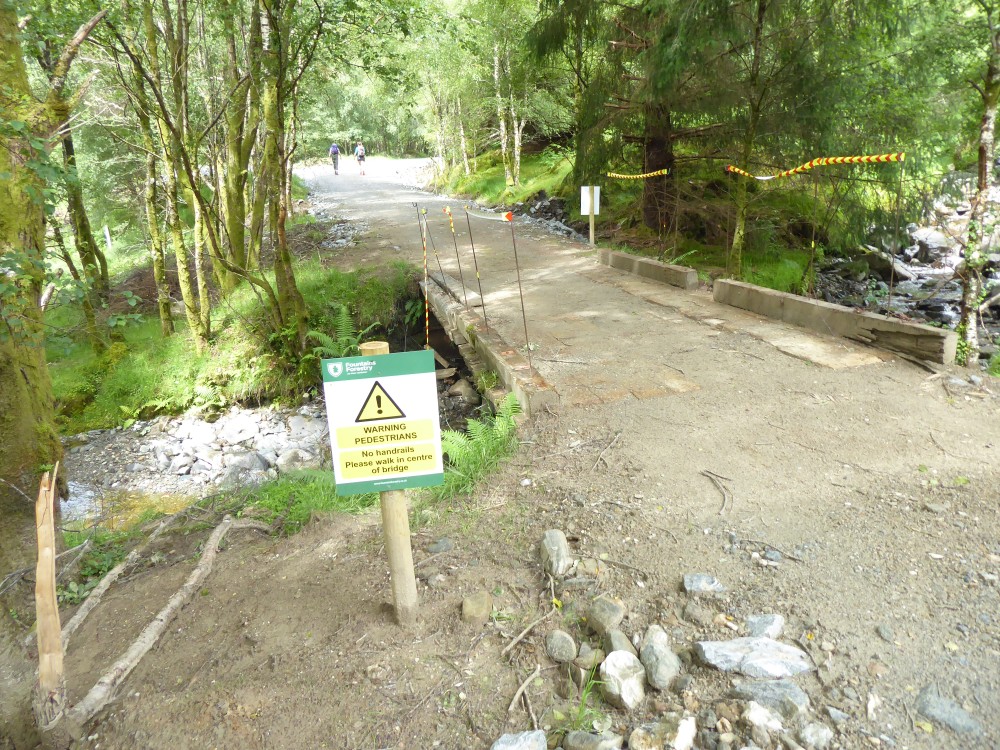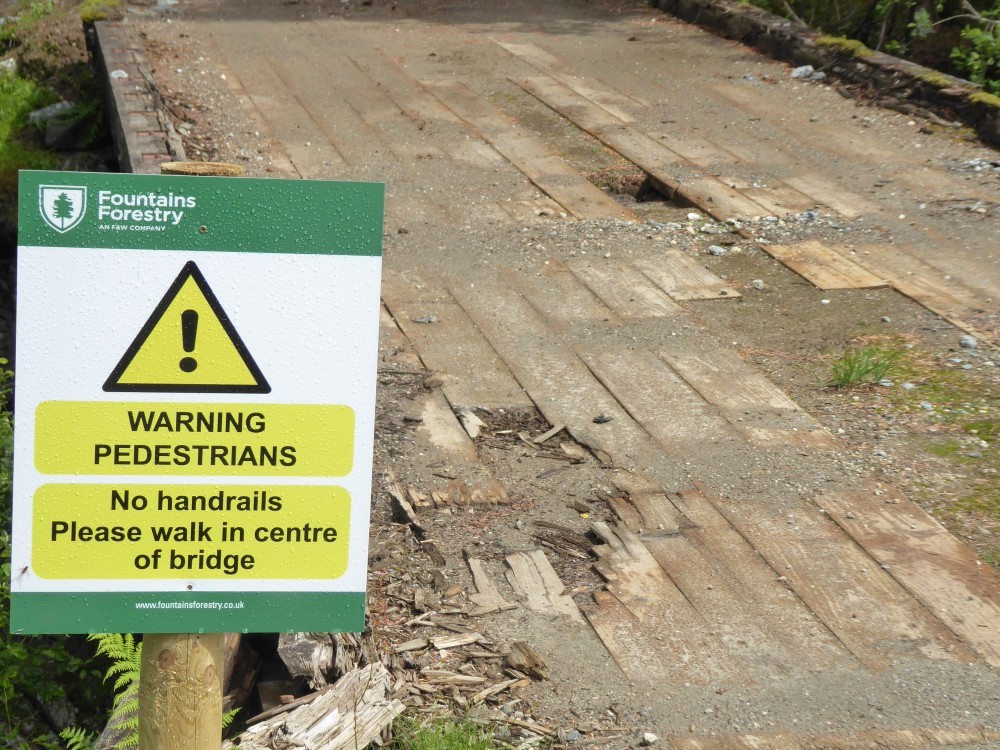
Part of the reason for my recent visit to Balquhidder (see here) was to take a closer look at the forestry plantation in Monachyle Glen, the one which was sold off on the cheap by Forest and Land Scotland (see here). The road up the glen has been upgraded in preparation for timber harvesting/profit reaping and various new health and safety signs have been erected.
Health and safety is, of course, extremely important. Far too many people still die or are injured at work as a result of health and safety failings. The lack of adequate health and safety measures that were in place to protect NHS, other staff and the general population during the early stages of the Covid pandemic provides a notable recent example and resulted in hundreds of unnecessary deaths. There are, however, important differences between the moral and statutory duties of employers under Health and Safety legislation and the moral and obligations of landowners and land-managers in relation to the in relation to people exercising their access rights.
The Land Reform (Scotland) Act 2003, which enshrined the freedom to roam in law, created no new health and safety obligations for landowners and left the law on occupiers liability as it was. Over time both statute and case law had established that, broadly speaking, the public who visited the countryside for outdoor recreation did so at their own risk. The main obligation of landowners under health and safety legislation and the duty to care was to alert the public to “unnatural” risks, like hidden mineshafts, and land management operations which could cause accidents . The consequence was a healthy distinction between the responsibilities of landowners/managers and the responsibilities of visitors to the countryside who were expected to take reasonable regard for their own health and safety.
This has mostly worked very well and in relation to potentially dangerous activities like deer stalking, land managers have managed to carry out on shooting deer safely with no risk to the public with very little impact on rights of access. It has been considerably helped by both “sides” being prepared to co-operate on the ground and showing a degree of common sense.
In the twenty years since the Land Reform Act was passed, however, some of those separate responsibilities have started to blur. The worst example is Historic and Environment Scotland’s closure of the Radical Rd in Edinburgh (see here) due to the natural hazard of stonefall on Salisbury Crags. If that was applied Scotland wide mountaineering as an activity would stop tomorrow. While HES have only been able to do this because of the arcane Holyrood Park Regulations, which should have been repealed 20 years ago, their action does risk setting a precedent that it is acceptable to limit access to parts of the countryside which are inherently dangerous on health and safety grounds.
The danger is that once health and safety is viewed as applying generally to the exercise of access rights, which includes the right to use bridges across rivers, it will grow arms and legs. The photo above provide a good example. Why warn people that there are no handrails when this is obvious (except to people with visual impairments who could not read the sign!).
There is no need for handrails or safety tape on bridges such as this, a mere two feet above the burn, and to suggest otherwise risks creating huge costs for landowners. The consequences of handrails becoming standard “safety” practice on bridges such as this are predictable: some landowners will choose to remove bridges rather than incur such costs. Ironically, this will increase the likelihood of accidents as walkers cross burns in spate or slip while boulder hopping.
Many visitors to the countryside will have chosen to use bridges that are far narrower and more dangerous then this and some will have chosen to use a single ricketty plank that some unknown person has placed across a burn. An integral part of outdoor recreation is weighing up the options and risks as part of making choices. If the person then has an accident that should be viewed as their responsibility not the responsibility of the landowner.

This post was prompted by another bridge, slightly lower down the glen, where there was a hole in exactly the place where Fountains Forestry was advising pedestrians to walk due to the lack of a handrail! Ridiculous health and safety advice! While reasonably obvious in daylight, the hold was not nearly so obvious as the lack of a handrail and could easily be missed in the dark. If the Fountain Foresty safety tape should have been anywhere, it should have been around this hole!
The unthinking application of health and safety to obvious risks associated with land-management in the countryside not only exposes health and safety to ridicule (not a good think as it is a serious matter) but also threatens undermine the principle that visitors have a responsibility to take reasonable care for their own safety. While under health and safety legislation land managers clearly have obligations to take precautions to prevents accidents – such as the hole in the bridge which poses risks to both staff and visitors – it should not be taken too far as in the “warnings” about the lack of handrails and applied to “risks” that are obvious. Health and safety needs to focus on what matters.
The forest industry has in my view generally got better in the twenty years since the Land Reform Act in reconciling health and safety considerations with access rights. For example, instead of trying to shut down access to whole forests when felling operations are taking place, as a result of dialogue with recreational organisations like the Ramblers it has developed a suite of measures to enable continued access while protecting people from risks such as being run over by machinery or hit by falling trees. It is now, for example, almost standard practice for machine operators to stop to let walkers past. That is to be commended and every visitor to forests should show their appreciation.
It would be a great shame if that shared approach to risk, which is based on the common sense view that everyone needs to take responsibility for their own actions (in forests that means waiting to make sure the machine operators have seen you), were undermined by managers trying to guard themselves against every conceivable risk.
If we, by which I mean both land managers and outdoor recreationists, are not prepared to draw and line and clearly state that handrails are not needed on broad bridges for pedestrians then the implications for footpaths and access more generally are immense..
At what stage a concept of ‘social responsibility’ will become enshrined in law, is a debate worth having. If it becomes accepted that a built structure was known to present a hazard to those who use it, then ‘flagging’ the potential risk to those crossing it could be argued as serving the wider interests of the public.( However absurd of obvious the danger might appear to a fit person?
This is a far cry from a recent move towards compulsory courses and a level of pre- Qualification to show capability, before regional permits will be issued to access some areas in higher mountain ranges , or even more draconian before being permitted to take part in some water sports events.
A couple of days ago I heard that every crew member of every yachts wishing to face the challenge of the Sydney- Hobart race, must undertake the Coastguard approved multi day sea survival course before they can participate . This matches the mindset of authority in the high Himalaya now, or the Alps. This example serves to indicate the type of risk-averse ‘ micro-manage’ mindset, which seems certain to further define ‘misadventure’ as being either wilful, ignorant, or accidental, through decades to come? Lawyers are sure to keep that pot boiling…..
One reason for the tendency to provide unnecessary safeguards like the notice over the bridge without rails, certainly in some cont4exts, is not so much about the safety of the public but the safety of the organisation concerned. That is even if an injured party demands damages, sues etc, It still costs organisations time and expensive lawyers fees in defending the unjustified case.
The classic situation where this lurked, and still does, was the issue of providing free access of a largely urban based ( ie mountain inexperienced) public to Cairngorm after being delivered there by the companies own facility and at the invitation of the company – ie via Cairngorm Mountain’s funicular, into an acknowledged potentially dangerous and rather unpredictable environment – especially when your are delivering them into that situation by the thousand!